Experimental Study on Macroscopic Mechanical Characteristics and Microscopic Pore Structure Evolution of Soil–Rock Mixture under Repeated Freeze–Thaw Cycles
Abstract
:1. Introduction
2. Materials and Methods
2.1. Test Materials and Specimens
2.2. Freeze–Thaw Cycle Test
2.3. Electrochemical Test and Uniaxial Compression Test
2.4. Numerical Simulation of Particle Flow Programs
3. Results and Analysis
3.1. Effect of Freeze–Thaw Cycle on Mesoscopic Pore Structure of Soil–Rock Mixture
3.2. Effect of Freeze–Thaw Cycles on Mechanical Properties of Soil–Rock Mixtures
4. Conclusions
- (1)
- Under different freeze–thaw cycle conditions, the similarity of distribution characteristic angles in soil–rock mixtures can indirectly represent the microporosity. The similarity and the tangent values of the distribution characteristic angles in the soil–rock mixture exhibit a good exponential relationship with the number of freeze–thaw cycles. As the freeze–thaw cycles increased, the number of microscopic pores within the soil–rock mixture gradually increased, and the tangent values of the distribution characteristics decreased while the similarity increased.
- (2)
- The uniaxial compressive strength, peak secant modulus, and peak strain of the soil–rock mixture had good exponential relationships with the number of freeze–thaw cycles. The uniaxial compressive strength and peak secant modulus both exhibited exponential decay with an increasing number of freeze–thaw cycles. However, the peak strain showed an exponential increase trend. In addition, the stage of pore compaction also shows an increasing trend with an increasing cycle.
- (3)
- With an increasing number of freeze–thaw cycles, the effective modulus (emod)/bonded effective modulus (pb_emod) and the cohesion (pb_coh)/tensile strength (pb_ten) both exhibited decreasing trends. The strain of the soil and rock mixture when cracks begin to germinate also increased significantly. Under different freeze–thaw cycles, the failure modes and crack propagation patterns of the soil–rock mixture were generally similar. The crack propagation extended from the edges and corners toward the middle-lower part, with partial expansion toward both ends in the central region. The failure crack type was mainly tensile failure, followed by tensile–shear failure, and the compression–shear failure occurred the least.
- (4)
- Under different freeze–thaw cycles, there was a good linear relationship between the similarity of the soil–rock mixture and uniaxial compressive strength. The uniaxial compressive strength exhibited a linear decrease with an increasing similarity.
Author Contributions
Funding
Institutional Review Board Statement
Informed Consent Statement
Data Availability Statement
Acknowledgments
Conflicts of Interest
References
- Xu, W.H.R. Particle size fractal characteristics of the soil–rock mixtures in the right bank slope of Jinsha River at Long-Pan, Tiger-Leaping Gorge area. Engng. Geol. 2006, 14, 496–501. (In Chinese) [Google Scholar]
- Xu, W.J.; Hu, R.L.; Tan, R.J. Some geomechanical properties of soil-rock mixtures in the Hutiao Gorge area, China. Geotechnique 2007, 57, 255–264. [Google Scholar] [CrossRef]
- Xua, W.J.; Xu, Q.; Hu, R.L. Study on the shear strength of soil-rock mixture by large scale direct shear test. Int. J. Rock Mech. Min. 2011, 48, 1235–1247. [Google Scholar] [CrossRef]
- Yu, J.; Jia, C.J.; Xu, W.Y.; Zhang, Q.; Wu, C.J. Granular discrete element simulation of the evolution characteristics of the shear band in soil-rock mixture based on particle rotation analysis. Environ. Earth Sci. 2021, 80, 213. [Google Scholar] [CrossRef]
- Kahraman, S.; Alber, M. Estimating unconfined compressive strength and elastic modulus of a fault breccia mixture of weak blocks and strong matrix. Int. J. Rock Mech. Min. 2006, 43, 1277–1287. [Google Scholar] [CrossRef]
- Gao, W.H.R.; Oyediran, I.A.; Li, Z.Q.; Zhang, X.Y. Geomechanical characterization of zhangmu soil-rock mixture deposit. Geotech. Geol. Eng. 2014, 32, 1329. [Google Scholar] [CrossRef]
- Holtz, W.G.; Ellis, W. Triaxial shear characteristics of clayey gravel soils. J. Soil Mech. Found. Div. 1956, 820, 1–22. [Google Scholar]
- Wei, H.Z.; Xu, W.J.; Wei, C.F.; Meng, Q.S. Influence of water content and shear rate on the mechanical behavior of soil-rock mixtures. Sci. China Technol. Sc. 2018, 61, 1127–1136. [Google Scholar] [CrossRef]
- Gao, F.; Xiong, X.; Xu, C.S.; Zhou, K.P. Mechanical property deterioration characteristics and a new constitutive model for rocks subjected to freeze-thaw weathering process. Int. J. Rock Mech. Min. 2021, 140, 104642. [Google Scholar] [CrossRef]
- Xiao, Y.G.; Deng, H.W.; Tian, G.L.; Yu, S.T. Analysis of Microscopic Pore Characteristics and Macroscopic Energy Evolution of Rock Materials under Freeze-Thaw Cycle Conditions. Mathematics 2023, 11, 710. [Google Scholar] [CrossRef]
- Wei, Z.N.; Yang, W.; Zhai, C.; Sun, Y.; Tang, W.; Chen, A.K.; Xu, H.X.; Wang, Y. Freezing characteristics and microstructural damage evolution of granular materials in cold regions under freezing-thawing cycles. Environ. Earth Sci. 2023, 82, 191. [Google Scholar] [CrossRef]
- Tang, L.Y.; Lu, Z.H.; Zheng, J.J.; Zheng, J.G.; Jin, L.; Yu, Y.T.; Jia, H.L.; Sun, Q.; Wu, D.; Li, G. Mechanism of strength degradation of frozen soil-rock mixture under temperature rise-induced particle ice film ablation. Permafr. Periglac. 2023. early access. [Google Scholar] [CrossRef]
- Xing, K.; Zhou, Z.; Yang, H.; Liu, B.C. Macro-meso freeze-thaw damage mechanism of soil-rock mixtures with different rock contents. Int. J. Pavement. Eng. 2020, 21, 9–19. [Google Scholar] [CrossRef]
- Zhou, Z.; Li, F.; Yang, H.; Gao, W.Y.; Miao, L.W. Orthogonal experimental study of soil-rock mixtures under the freeze-thaw cycle environment. Int. J. Pavement. Eng. 2021, 22, 1376–1388. [Google Scholar] [CrossRef]
- Zhou, Z.; Xing, K.; Yang, H.; Wang, H. Damage mechanism of soil-rock mixture after freeze-thaw cycles. J. Cent. S Univ. 2019, 26, 13–24. [Google Scholar] [CrossRef]
- Tang, L.Y.; Li, G.; Luo, T.; Jin, L.; Yu, Y.T.; Sun, Q.; Li, G.Y. Mechanism of shear strength deterioration of soil-rock mixture after freeze-thaw cycles. Cold Reg. Sci. Technol. 2022, 200, 103585. [Google Scholar] [CrossRef]
- Tang, L.Y.; Li, G.; Li, Z.; Jin, L.; Yang, G.S. Shear properties and pore structure characteristics of soil-rock mixture under freeze-thaw cycles. B Eng. Geol. Environ. 2021, 80, 3233–3249. [Google Scholar] [CrossRef]
- Xu, W.J.; Zhang, H.Y. Research on the effect of rock content and sample size on the strength behavior of soil-rock mixture. B Eng. Geol. Environ. 2021, 80, 2715–2726. [Google Scholar] [CrossRef]
- Medley, E.W. The Engineering Characterization of Melanges and Similar Block-in-Matrix Rocks (Bimrocks); University of California: Berkeley, CA, USA, 1994. [Google Scholar]
- Dong, H.; Zhu, X.; Chen, L.; Luo, Z.; Jiang, X. Study on pore characteristics of soil-rock mixture resistance similarity based on the electrochemical impedance spectroscopy. Chin. J. Sci. Instrum. 2020, 41, 119–128. (In Chinese) [Google Scholar]
- Bard, A.J.; Faulkner, L.R. Electrochemical Methods Fundamentals and Applications, 2nd ed.; Shao, Y.H.; Zhu, G.Y.; Dong, X.D., Translators; Chemical Industry Press: Beijing, China, 2005. [Google Scholar]
- Andrade, C.; Blanco, V.M.; Collazo, A.; Keddam, M.; Nóvoa, X.R.; Takenouti, H. Cement paste hardening process studied by impedance spectroscopy. Electrochim. Acta 1999, 44, 4313–4318. [Google Scholar] [CrossRef]
- GB/T 50123-2019; Geotechnical Test Method Standard. Ministry of Water Resources of the People’s Republic of China. China Standard Press: Beijing, China, 2019. (In Chinese)
- Cundall, P.A.; Strack, O.D.L. A discrete numerical model for granular assemblies. Geotechnique 1979, 29, 47–65. [Google Scholar] [CrossRef]
- Zhao, Z.L.; Wang, X.; Wen, Z.J. Analysis of Rock Damage Characteristics Based on Particle Discrete Element Model. Geotech. Geol. Eng. 2018, 36, 897–904. [Google Scholar] [CrossRef]
- Ning, J.G.; Liu, X.S.; Tan, Y.L.; Wang, J.; Tian, C.L. Relationship of box counting of fractured rock mass with Hoek-Brown parameters using particle flow simulation. Geomech. Eng. 2015, 9, 619–629. [Google Scholar] [CrossRef]
- Li, J.L.; Zhu, L.Y.; Zhou, K.P.; Liu, H.W.; Cao, S.P. Damage characteristics of sandstone pore structure under freeze-thaw cycles. Rock Soil Mech. 2019, 40, 3524–3532. [Google Scholar] [CrossRef]
- Gao, F.; Xiong, X.; Zhou, K.P.; Li, J.L.; Shi, W.C. Strength deterioration model of saturated sandstone under freeze-thaw cycles. Rock Soil Mech. 2019, 40, 926–932. [Google Scholar] [CrossRef]



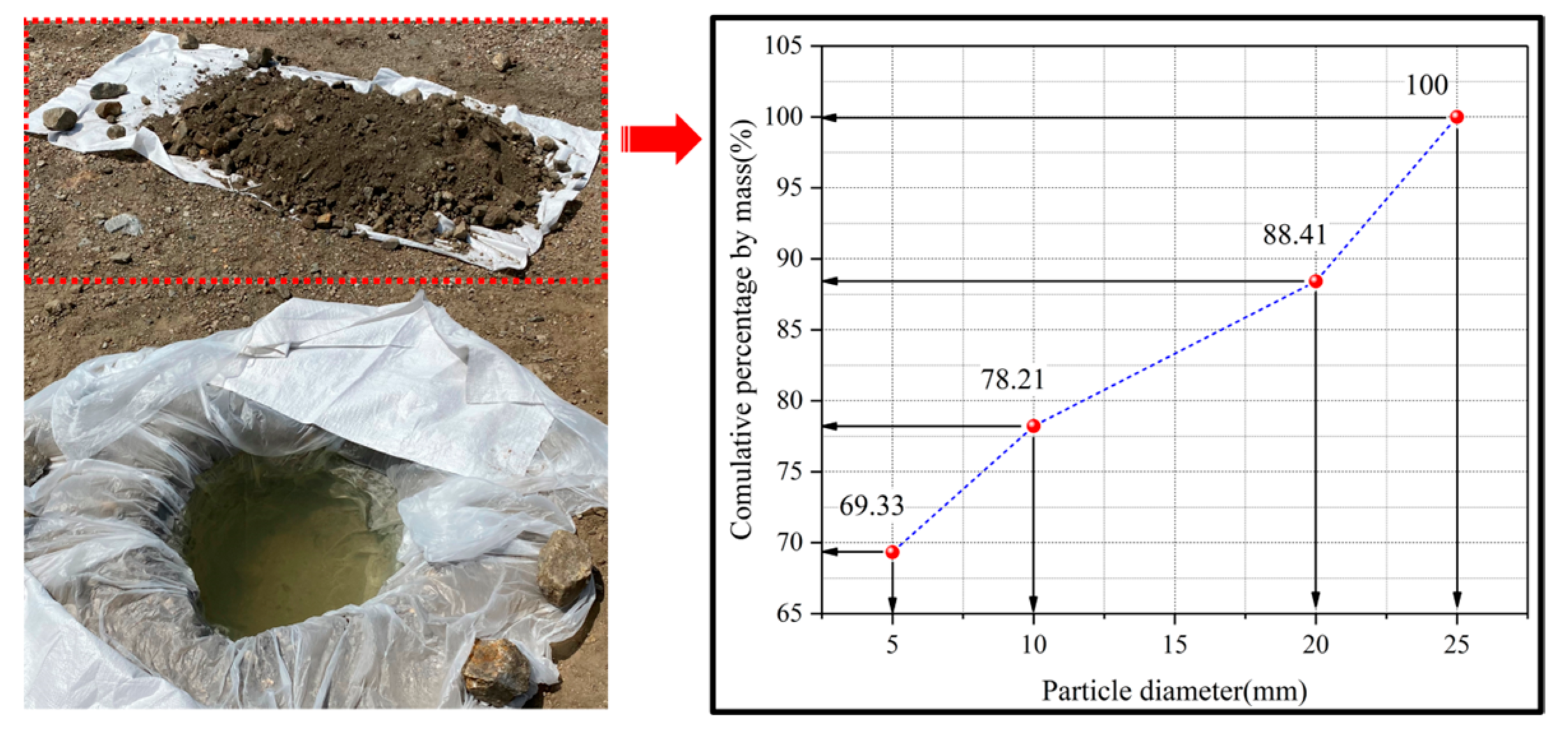
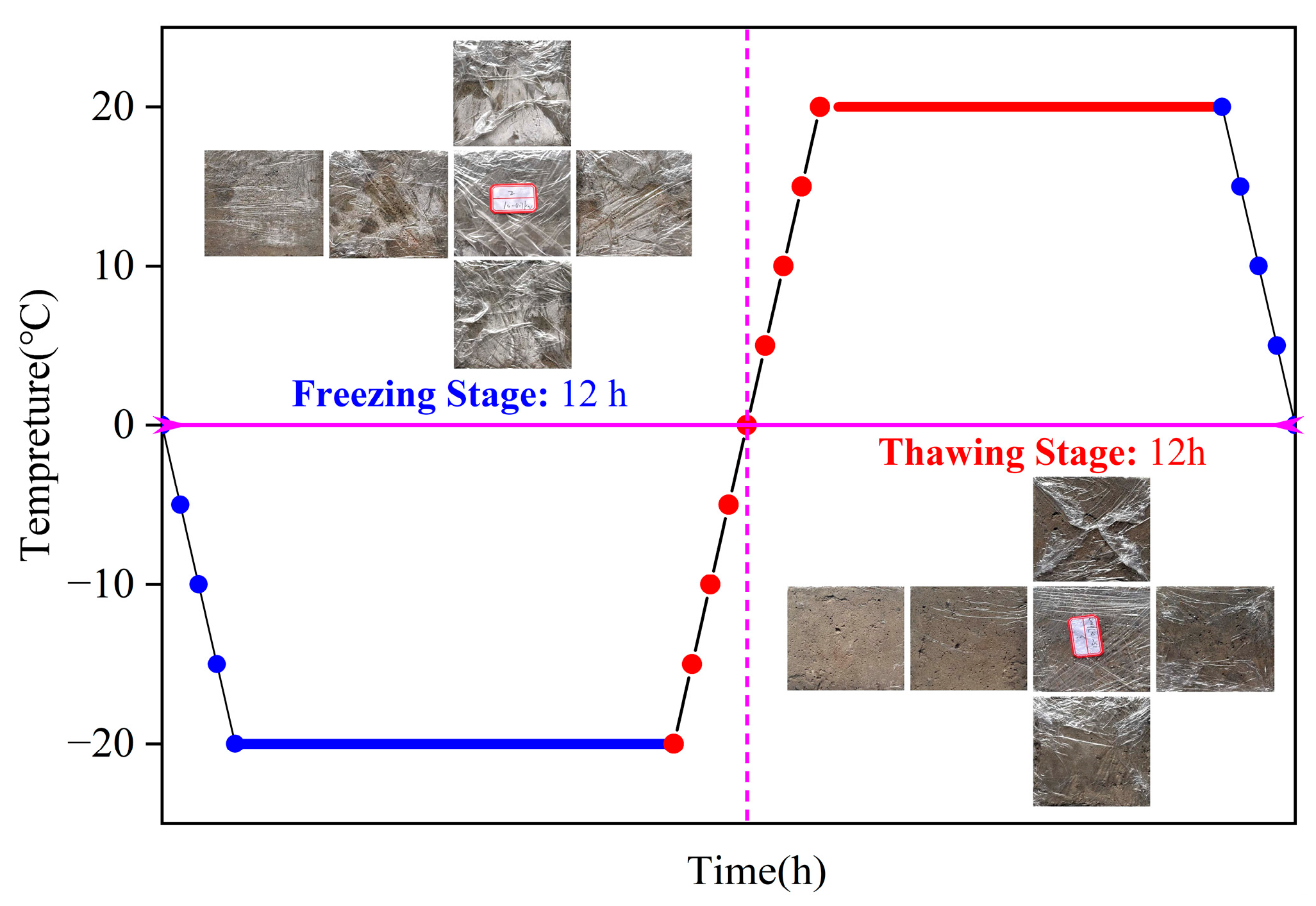
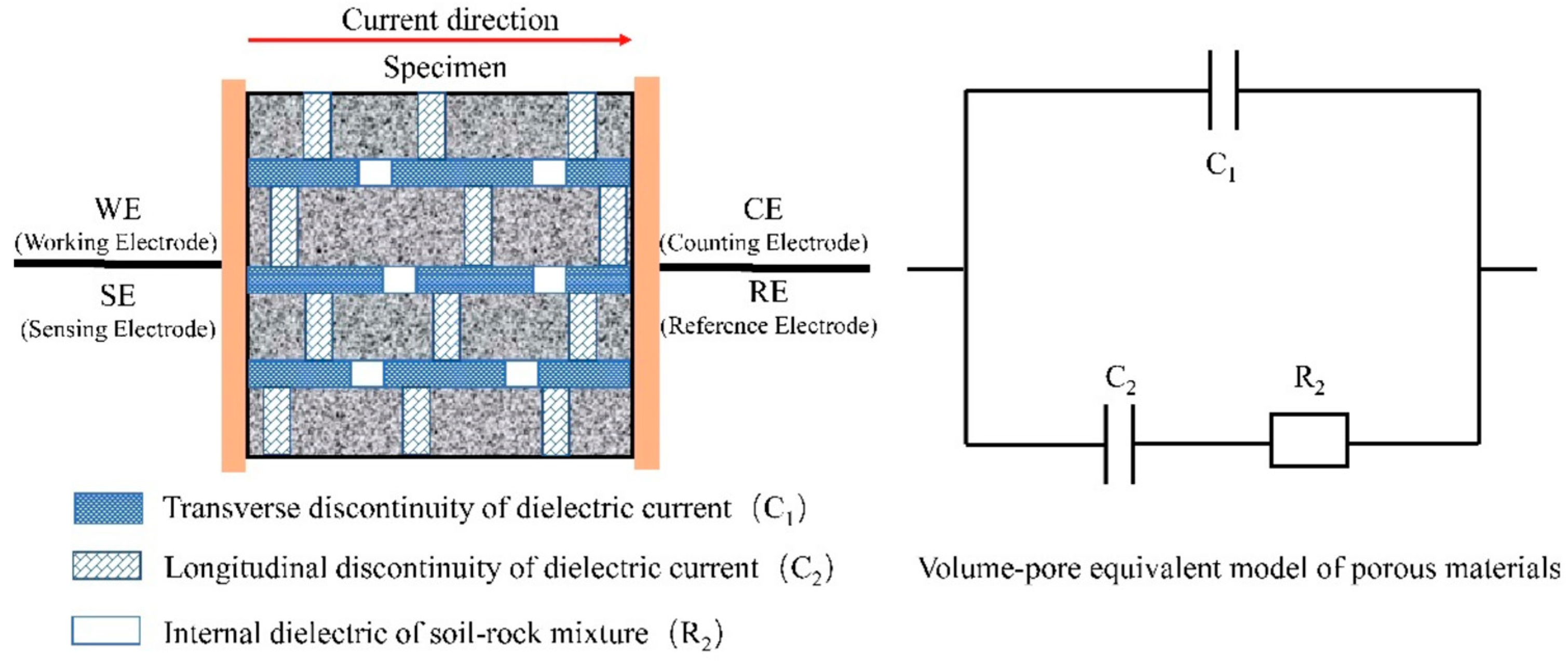
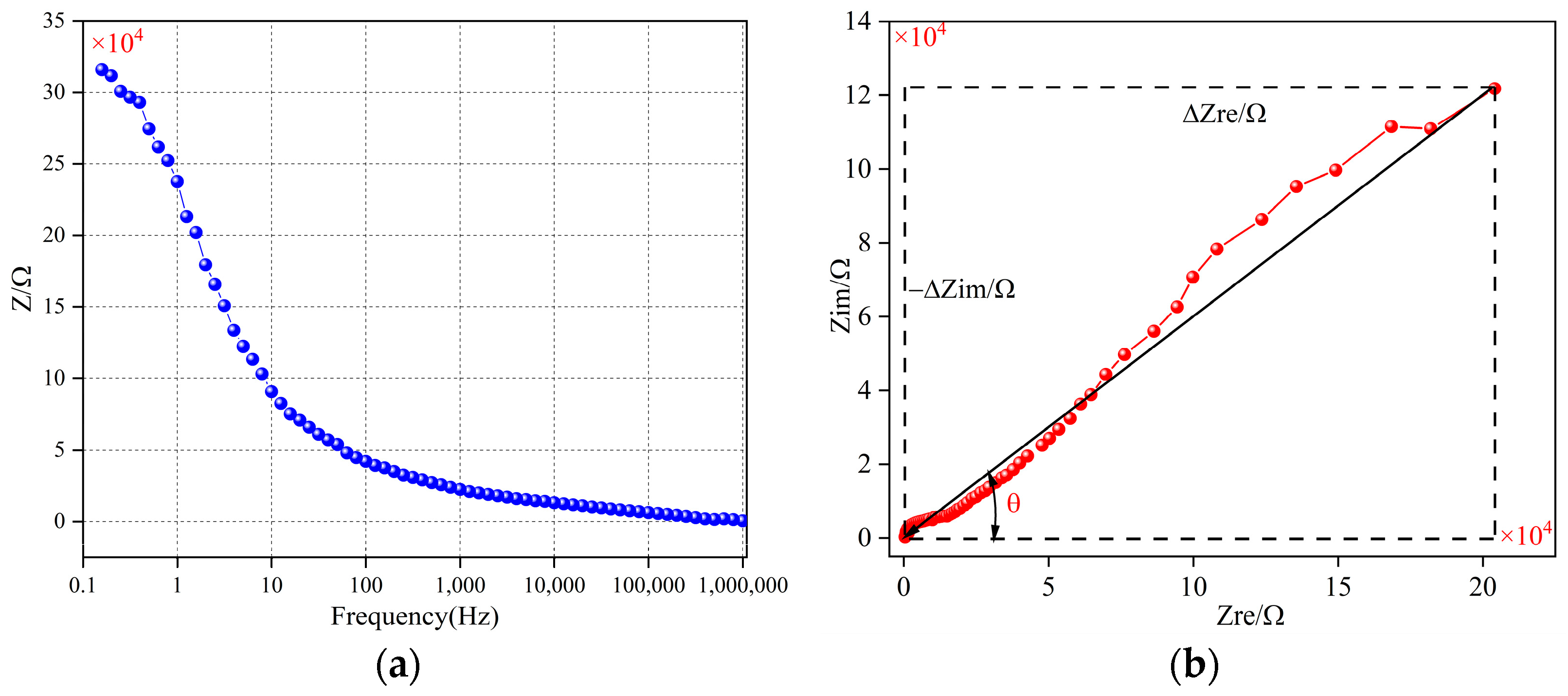


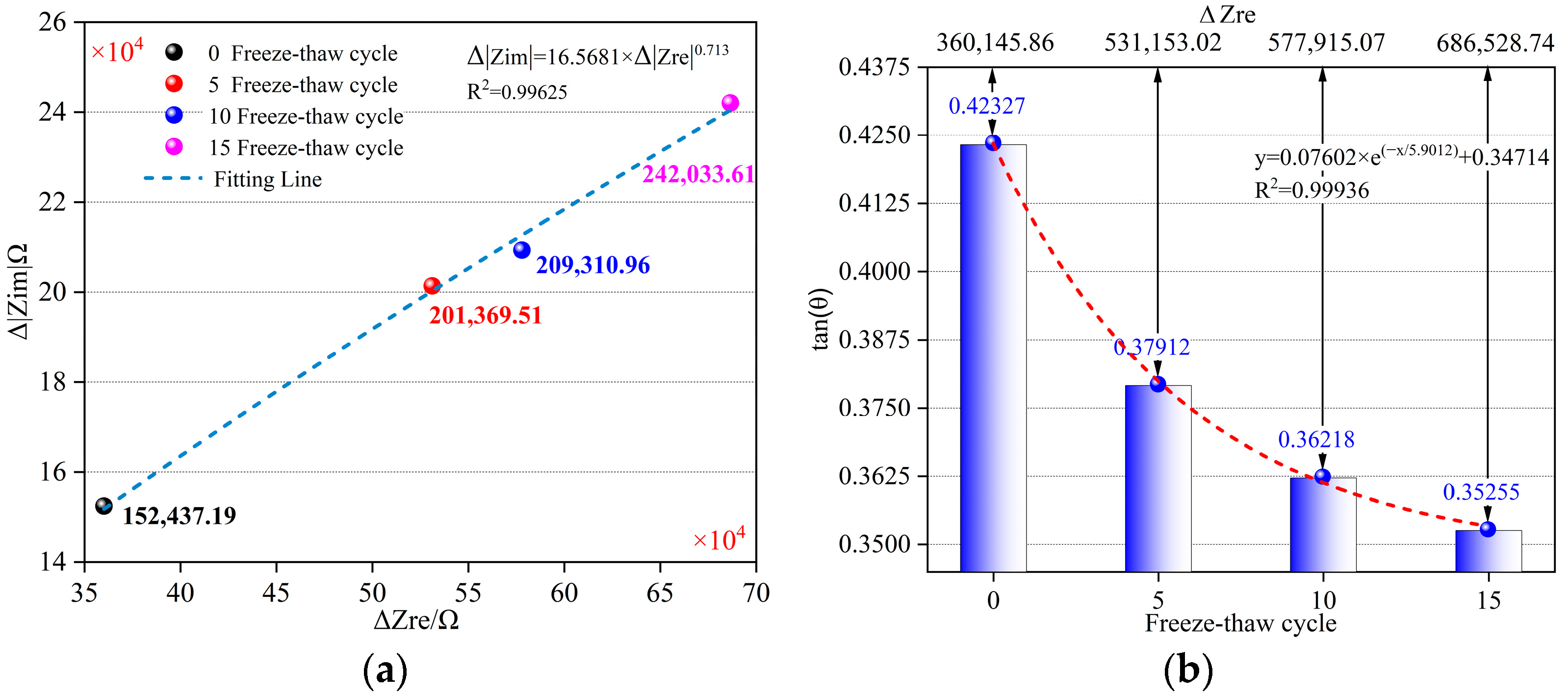

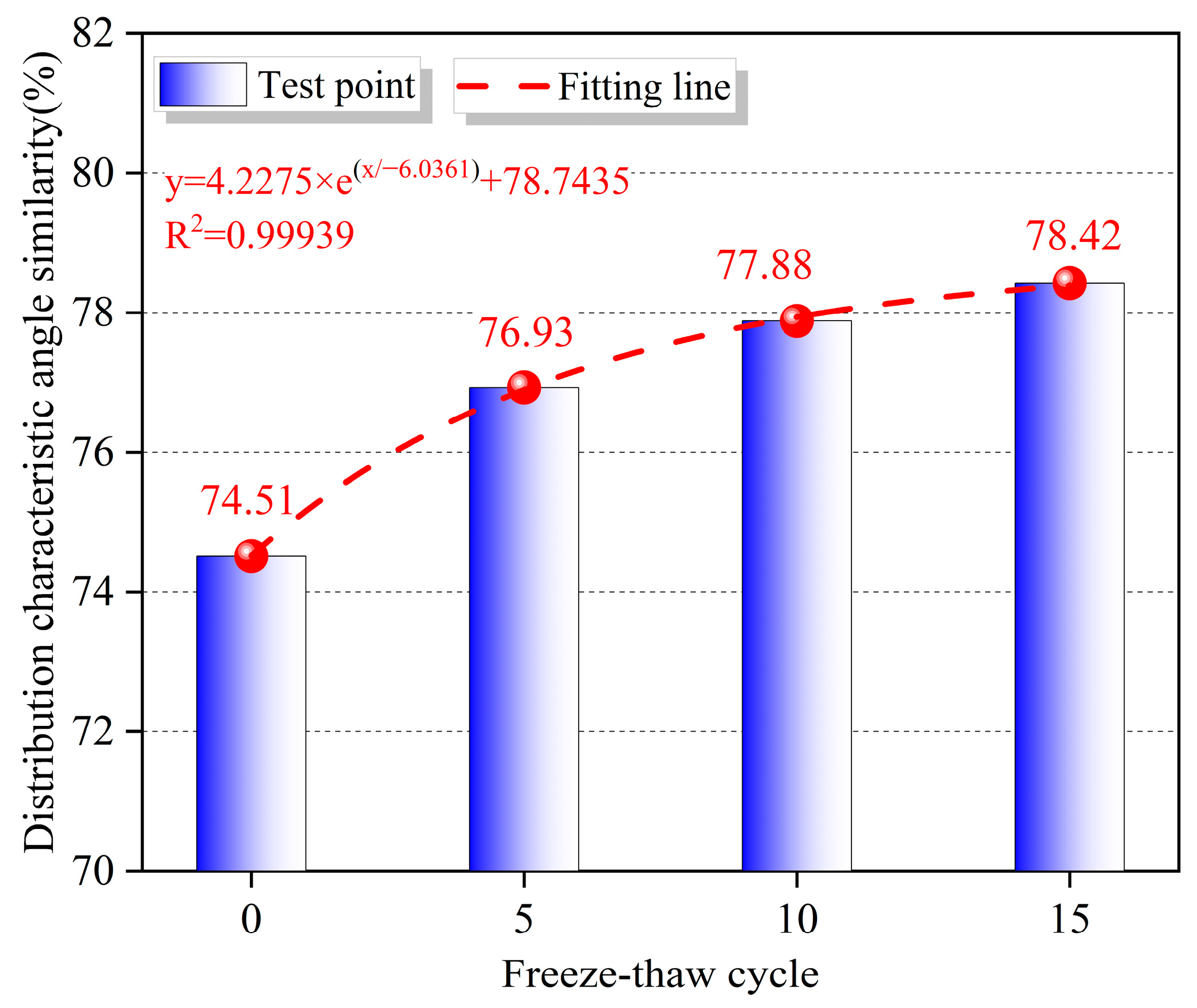


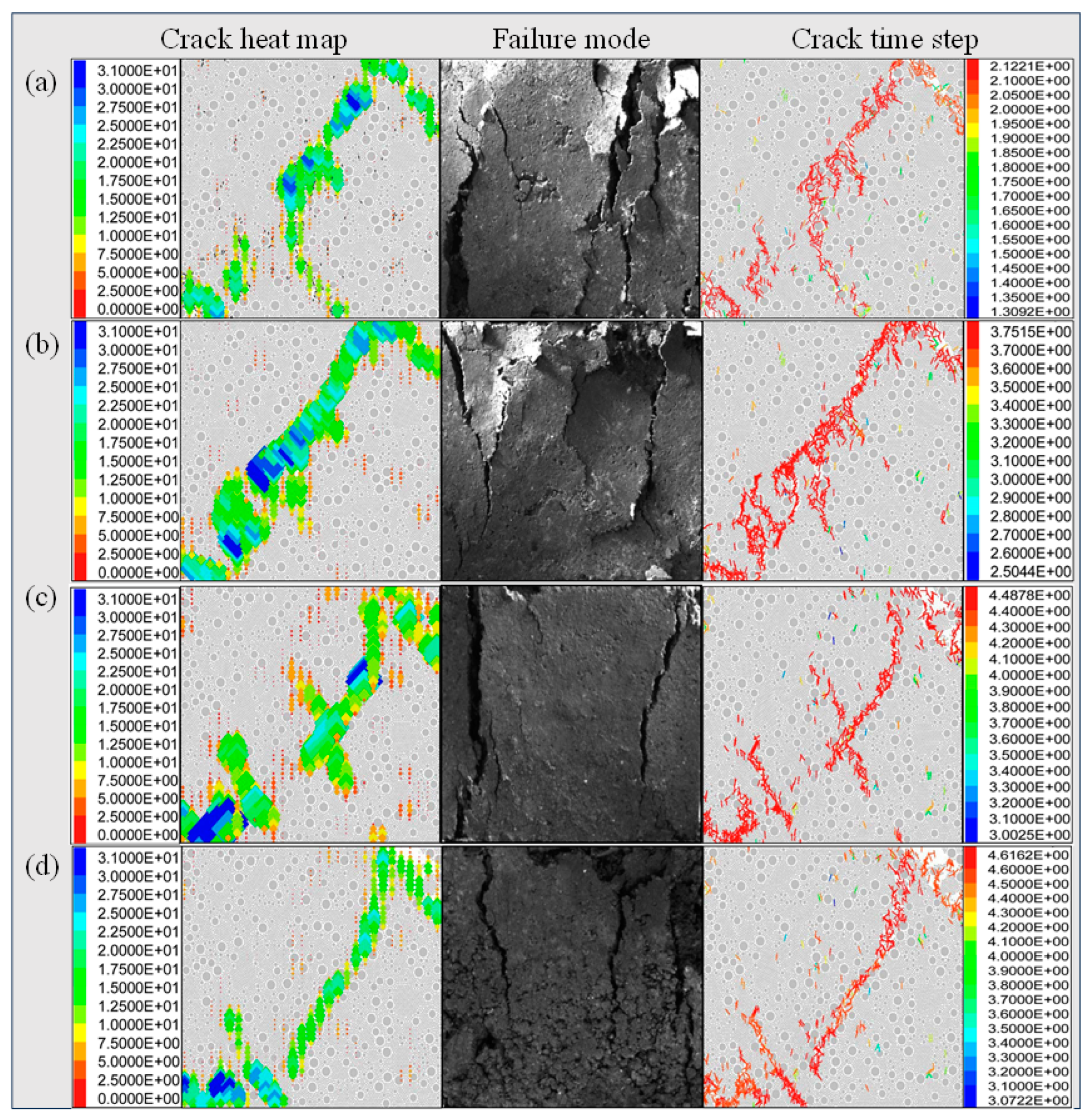
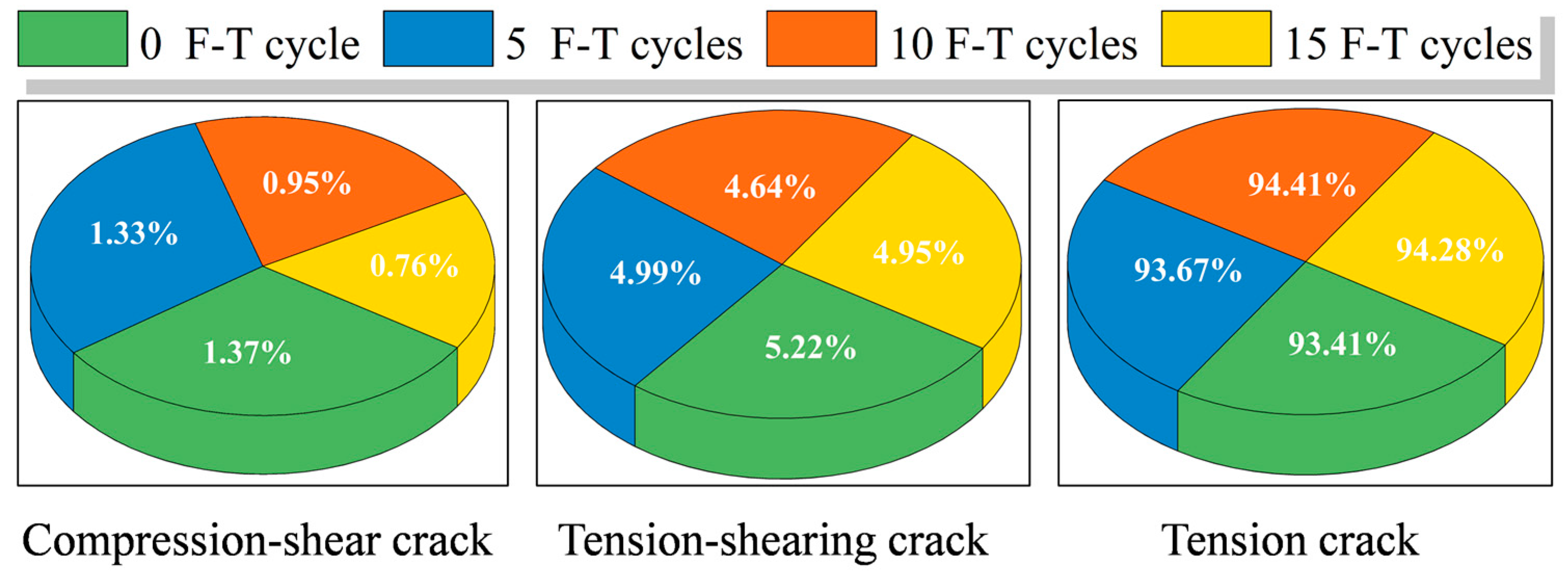

| Main Parameters | Start Frequency (Hz) | End Frequency (Hz) | Data Quality | Current Range (mA) | Voltage Range (V) | Electrometer Mode |
|---|---|---|---|---|---|---|
| Parameter value | 1,000,000 | 0.01 | 3 | 2 | +/−6 | Differential |
| F-T Cycle | Density (kg/m3) | Kratio | Porosity | Fric | emod/ pb-Emod (GPa) | pb_coh/ pb_ten (MPa) | pb_fa (°) |
|---|---|---|---|---|---|---|---|
| 0 | 2407 | 1.5 | 0.03 | 0.5 | 0.6698 | 0.3594 | 40 |
| 5 | 0.2117 | 0.2889 | |||||
| 10 | 0.1982 | 0.2381 | |||||
| 15 | 0.1509 | 0.1882 |
| F-T Cycle | Peak Secant Modulus (GPa) | Peak Stress (MPa) | ||||
|---|---|---|---|---|---|---|
| Indoor Test Parameters | Numerical Simulation Parameters | Error | Indoor Test Parameters | Numerical Simulation Parameters | Error | |
| 0 | 0.01649173 | 0.01642503 | 6.66996 × 10−5 | 0.3488 | 0.34259 | 0.00621 |
| 5 | 0.00740491 | 0.007418277 | 1.33674 × 10−5 | 0.2745 | 0.27475 | 0.00025 |
| 10 | 0.00519312 | 0.005171005 | 2.2115 × 10−5 | 0.2326 | 0.22909 | 0.00351 |
| 15 | 0.00398003 | 0.003963142 | 1.68878 × 10−5 | 0.1834 | 0.18004 | 0.00336 |
Disclaimer/Publisher’s Note: The statements, opinions and data contained in all publications are solely those of the individual author(s) and contributor(s) and not of MDPI and/or the editor(s). MDPI and/or the editor(s) disclaim responsibility for any injury to people or property resulting from any ideas, methods, instructions or products referred to in the content. |
© 2023 by the authors. Licensee MDPI, Basel, Switzerland. This article is an open access article distributed under the terms and conditions of the Creative Commons Attribution (CC BY) license (https://creativecommons.org/licenses/by/4.0/).
Share and Cite
Deng, H.; Zhao, B.; Xiao, Y.; Tian, G. Experimental Study on Macroscopic Mechanical Characteristics and Microscopic Pore Structure Evolution of Soil–Rock Mixture under Repeated Freeze–Thaw Cycles. Appl. Sci. 2023, 13, 11504. https://doi.org/10.3390/app132011504
Deng H, Zhao B, Xiao Y, Tian G. Experimental Study on Macroscopic Mechanical Characteristics and Microscopic Pore Structure Evolution of Soil–Rock Mixture under Repeated Freeze–Thaw Cycles. Applied Sciences. 2023; 13(20):11504. https://doi.org/10.3390/app132011504
Chicago/Turabian StyleDeng, Hongwei, Bokun Zhao, Yigai Xiao, and Guanglin Tian. 2023. "Experimental Study on Macroscopic Mechanical Characteristics and Microscopic Pore Structure Evolution of Soil–Rock Mixture under Repeated Freeze–Thaw Cycles" Applied Sciences 13, no. 20: 11504. https://doi.org/10.3390/app132011504
APA StyleDeng, H., Zhao, B., Xiao, Y., & Tian, G. (2023). Experimental Study on Macroscopic Mechanical Characteristics and Microscopic Pore Structure Evolution of Soil–Rock Mixture under Repeated Freeze–Thaw Cycles. Applied Sciences, 13(20), 11504. https://doi.org/10.3390/app132011504







